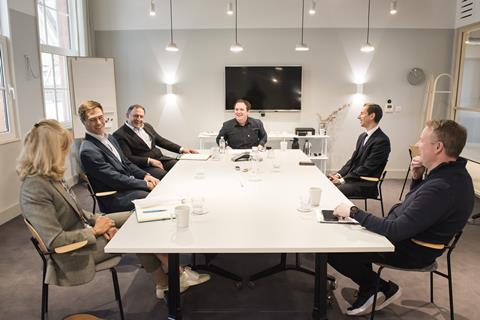Property Week and Yardi brought together a panel of experts to discuss the changing role of asset management, the specific challenges the sector faces, how Covid has affected occupier expectations and how data and technology can be used to help overcome problems in the future.

Panel of experts
Christian Armstrong, chief experience officer, Get Living
Robert Butterworth, senior manager – portfolio optimisation, Asda
Mike Cook, regional director, Yardi
Emma Mackenzie, director, head of asset management and ESG, NewRiver REIT
Ben Sawbridge, asset manager, Urban Logistics REIT
Simon Creasey, Property Week (chair)





How has asset management and the role of asset managers changed over the last few years?
Butterworth: I have worked at Asda for about 10 years and it has changed a lot in that time. We have become much more focused on adding quality tenants to our tenanted portfolio and looking at the services they can offer and then ensuring the tenant is going to trade well, because the last thing you need is a poor-trading tenant. We also do not get 20-year leases now. Typically, tenants are taking a 10-year lease and most would like a five-year break as well. And in the last maybe three to four years, we have also operated more on a turnover basis, so if they are successful, we are successful.
Mackenzie: I think asset management has moved on significantly in the last 10 years, principally, because gut feel is all very well but it absolutely has to be underpinned by data, facts, figures, analysis and understanding. All the data that you can generate is at your fingertips now and the role of the asset manager is digesting all that information, computing it and really being informed before making decisions.
If there is a silver lining to the global pandemic, it has shown how nimble people can be, and how nimble and reactive businesses can be, particularly around technology. Without technology in the last 18 months we would have been in an horrendous position.
Sawbridge: Over the last 18 months there has been a massive demand for logistics space. We have seen a trend of tenants looking at more expensive fit-outs with things like increasing automation becoming more and more common. I have been really impressed with how quickly some occupiers were able to react and alter their supply lines during lockdown, and we look to work with our tenants to help them wherever possible.
We need to make sure we work with occupiers to make sure they can continue to do well
Ben Sawbridge
Often the cost of moving and fitting out can mean that occupiers are looking to make longer-term commitments, which gives us the opportunity to work in close partnership with occupiers to help them prosper, because if the tenant does well it generally means that we will also do well.
Cook: We come at this from a slightly different angle in that we are a service provider to the industry, so we have to react to and foresee what the changes in the market will be, and I do not think anyone could see the impact that Covid was going to have. We have definitely seen a change in leasing and how that is approached and the churn of tenants has obviously been accelerated. But it has also opened up new markets for us in areas like coworking and around the recommissioning of existing assets to different sectors.
What sector-specific asset management challenges do you face?
Sawbridge: I am fortunate to have been in a sector over lockdown where the tenants were on the whole able to thrive. I think I read somewhere that the growth experienced in the logistics sector over the first eight months or so of the pandemic was what was predicted for the next five years.
The agenda for town centres has changed and that is the opportunity that has come out of the challenge
Emma Mackenzie
Having said that, occupiers are always trying to be as efficient as possible with how they use a building, whether operationally or when looking at sustainability and the ESG side of things, so we need to make sure we work with them to make sure they can continue to do well.
Mackenzie: The challenges, particularly around town centres and retail, were evident before the pandemic. In terms of the oversupply issue, that has been there for 20 years. If you compare graphs showing the amount of retail space that has been built over the last 20 years with the vacancy rate, the vacancy rate is tracking up and we are still building, building, building.
A lot of that space was built on the outskirts of towns and in retail parks and that then impacted town centres. Then you have a combination of the internet and online shopping, which has shifted a portion of spend online, and that has created the opportunity for retailers to downsize their physical presence and operate online. And that was all happening before Covid.
With the change in the way people live and the expectation that people will continue to work from home a couple of days a week, the rise in localism is absolutely feeding into a mixed-use town centre that people actually want to go to for a variety of reasons.
They want offices that are adaptable, flexible and that people can use as and when they require them. And they want to be able to go to the library or the dry cleaners – things that they cannot do online – and have a coffee or meet someone for something to eat. So the whole agenda for town centres has changed and that is the opportunity that has come out of the challenge.
Butterworth: Our challenge has been about keeping our sites relevant and investing in the customer experience. And that is not just about going through the door at an Asda; it is when you enter the site in your car. Over the last three to four years, we have invested in some of our big sites to try to attract the best tenants we can and it is really starting to pay dividends. I think Covid has pushed more tenants towards us because we have had that steady footfall throughout and people recognise we offer quality space at great value.
Covid has pushed more tenants towards us because we offer quality space at great value
Robert Butterworth
Armstrong: The build-to-rent (BTR) sector is positively on fire because everyone is investing in it, it is growing and there is still a great opportunity for growth in the sector. So one of the big challenges for us is how we continue to drive the value of our asset through that period because everyone is building the next biggest, shiniest development. So how do you stand out? How do you keep driving up the value of the asset to deliver returns for customers, stakeholder group and investors at the same time as continuing to invest in that thing? We are very conscious that to address that challenge we have to build what people want and need, but we also need to build in flexibility. So we need to build something that has the capability to be designed one way but in three to five years time can be converted to another way. We need that modularity or flexibility in space design.
What role do you think data and technology will play in helping to overcome these challenges?
Butterworth: We are in the process of implementing Yardi and we are doing that really because we want to bring all the data into one place. So whether it is turnover data from X, Y, Z retailer that is currently sitting on spreadsheets, what we want to do is give that visibility so we can analyse it and see which units do better than others and then try to come up with ways we can help or influence the output of those retail units.
I think the people who invest in the human relationship will come out the strongest
Christian Armstrong
Mackenzie: We have done a lot of work on determining what resilient retail looks like and using the data from our systems to categorise our own portfolio into long-term sustainable assets that are delivering and continue to deliver returns throughout the last two years and beyond the next seven years.
But we are also looking at how we can redeploy and continue to buy assets that will be sustainable for the long term. So that is about using research and partners to develop scorecards and mechanisms that cover the whole of the UK, picking out the criteria, identifying what actually is driving the returns in our existing portfolio and looking at where we can see that elsewhere in the country and where we want to redeploy our capital. And that is all data-driven.

We have great people and a great team of asset managers who all know what they are doing and have got a great gut feel, but when decisions are underpinned by real hard data the process becomes much more robust.
Cook: From our perspective the challenge has not changed, because we have products and we have roadmaps for those products. But what has changed is what is changing in your world, and that influences those roadmaps. One of the big things I have noticed that has come out of Covid is ‘tweaks’ to the way people operate, like changing a second bedroom into an office, or at the other end of the scale more dramatic changes like reassigning an asset to residential or turning a traditional office building into coworking. The challenge for us is accommodating that and making customers aware we have a solution that we can put in place.
You can only take technology so far – you will never replace that human interaction
Mike Cook
We are all in agreement that data and technology will play a bigger role in the way asset managers operate on a day-to-day basis in the future, especially as asset managers are going to become even more reliant on technology and machine learning and less on gut feel.
Mackenzie: Asset management people are absolutely the core of the business. They build relationships and know their assets, their occupiers, their customers, the towns, the councils, know every single stakeholder – and you cannot do that with data. Data informs you and it helps enormously, but nothing replaces face-to-face contact and the relationship with an individual or a business.
Armstrong: I think the people who invest in the human relationship alongside technology and data will come out the strongest. Those that just polarise on one side or the other are in trouble.
Cook: You can only take technology so far – you will never replace that human interaction. We will try and make life more efficient, more accurate and more accessible for our clients with properly connected data, but ultimately, in terms of asset managers, you are never going to replace them.































No comments yet